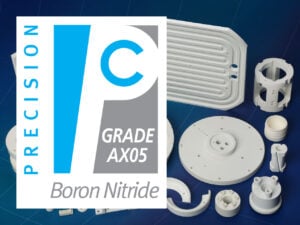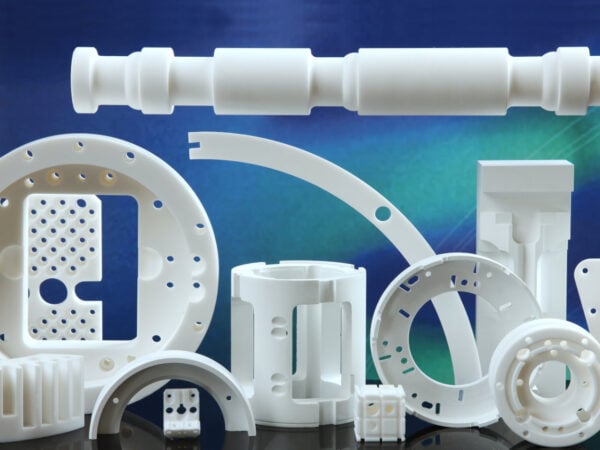Technical Ceramics in High Energy Physics
Ceramic Materials used in High Energy Physics

Alumina
CeramAlox™
Alumina,is a hard wearing advanced technical ceramic material with strong electrical, mechanical, and thermal properties and suitable for a variety of applications. Alumina is also suitable for metallising and joining to provide hermetic seals seals which are often required in Ultra High Vacuum or sealed atmosphere applications.

Aluminum Nitride
CeramAlum™
Aluminum Nitride (AlN) is an excellent material to use if high thermal conductivity and electrical insulation properties are required -- an ideal material for use in thermal management and electrical applications.

Macor®
Machinable Glass Ceramic
Macor is a hybrid glass-ceramic with the machinability of a metal, and the performance of an advanced technical ceramic. Macor is an excellent thermal and electrical insulator.

Shapal Hi M Soft™
Machinable AlN
Shapal Hi M Soft is a hybrid type of machinable Aluminum Nitride (AlN) ceramic that offers high mechanical strength, electrical insulation, and thermal conductivity.

Boron Nitride
Boron Nitride Grades
Boron Nitride (BN) is an advanced synthetic ceramic material available in solid and powder form. It has outstanding thermal conductivity, electrical insulation and thermal properties and is easy to machine.
Applications used in High Energy Physics Research

Particle Accelerators and Synchrotrons
These colossal machines accelerate particles to nearly the speed of light for scientific exploration. Synchrotrons fall into two major categories; high energy physics machines and sources of synchrotron light. Particle colliders in a variety of designs are used all over the world; one famous example being the Large Hadron Collider at CERN. Technical ceramics provide crucial components, examples being:
- Insulators: Their high dielectric strength prevents electrical breakdown in the intense electromagnetic fields.
- Vacuum Chambers: Their inertness and ability to withstand high temperatures and pressures create the ultra-high vacuum environment necessary for particle acceleration.
- Windows: Transparent ceramic windows allow for the observation of particle beams without affecting their path.
- Feedthroughs: Ultra high vacuum compatible ceramic-metal assemblies are used to provide power and connect to sensors and instrumentation. These are usually based on alumina ceramic.
- Shielding: Boron containing ceramics are commonly used in neutron shielding.

Neutron and Photon Research
Neutron and photon research is a fascinating field that involves studying the properties of matter by bombarding it with neutrons or photons. These tiny particles interact with the atoms and molecules in a material, providing valuable information about its structure, composition, and behaviour.
Neutrons
Neutrons are subatomic particles without an electric charge. This neutral nature allows them to penetrate deeply into matter without being deflected by electron clouds. This makes them particularly useful for studying the atomic structure of materials, including:
- Crystallography: Determining the arrangement of atoms in crystals.
- Magnetic structure: Investigating magnetic properties of materials.
- Materials science: Studying the properties of materials under different conditions.
Photons
Photons are particles of light. They interact with matter in various ways, including:
- X-ray diffraction: Determining the structure of crystals and molecules.
- Spectroscopy: Analysing the composition of materials by studying the interaction of light with matter.
- Imaging: Creating detailed images of objects, from biological cells to engineering components.
Ceramics play a vital role in generating and manipulating these particles:
- Neutron Sources: Ceramic components are used in neutron sources, where high-energy particles strike a target to produce neutrons.
- Photon Detectors: Advanced ceramics are employed in photon detectors, capturing and analyzing the light emitted by particles.
- Targets: The particle beam is usually directed from the synchrotron into an individual target station where experiments are performed. The ceramic materials may be used in the targets themselves, around the target assembly and within the sensing instruments surrounding the target.

Quantum Computing
- Quantum Circuitry: Their unique properties can be exploited for developing novel quantum computing components.
- UHV feedthroughs : Ceramic assemblies are used in UHV systems to provide power and connections to instruments.

Small Particle Research
- Microscopy: Ceramic components are used in the many types of electron microscopes, (SEM, TEM, STM, STEM, REM, FESEM), both in the microscope system function and the materials analysis and imaging equipment to visualize, and analyze samples.
- Particle Detection: Advanced ceramic materials help in developing detectors for capturing and studying small particles.
Datasheets

Alumina
All Grades CeramAlox

Aluminum Nitride
PCAN1000

Macor
Machinable Glass Ceramic

Shapal Hi M Soft™
Machinable Aluminum Nitride

Boron Nitride
Grade AX05
Frequently Asked Questions
-
Why are ceramics important in high energy physics?
Technical ceramics are crucial in high energy physics due to their exceptional properties that allow them to withstand extreme conditions.
Here’s a breakdown:
- Extreme Environments: Particle accelerators and synchrotrons generate immense heat, radiation, and pressure. Ceramics excel in withstanding these harsh conditions without degradation.
- Precision and Accuracy: The precise nature of high-energy physics experiments demands materials with exact properties. Ceramics offer consistent and predictable performance.
- Electrical Insulation: Many components in these experiments require excellent electrical insulation. Ceramics provide this property without compromising on mechanical or thermal characteristics.
- Vacuum Compatibility: Particle accelerators operate in ultra-high vacuum environments. Ceramics are inert and release minimal contaminants, making them ideal for these conditions.
In essence, technical ceramics provide the essential foundation for the complex machinery and experiments used in high energy physics research.
-
What are the key properties of ceramics that make them suitable for high energy physics applications?
Technical ceramics possess a unique combination of properties that make them indispensable in high energy physics:
- High and Low Temperature Resistance: Ceramics can withstand extremely high temperatures without melting or degrading, making them ideal for components exposed to intense heat generated during particle acceleration. Ceramics also perform well at very low temperatures often required for physics experiments.
- Excellent Thermal Conductivity or Insulation: Some ceramics efficiently transfer heat, preventing overheating and ensuring optimal performance of components. Other ceramic materials are excellent thermal insulators and may be used to provide a thermal barrier.
- Chemical Inertness: Ceramics are resistant to corrosion and chemical attack, preserving their integrity in aggressive environments.
- Electrical Insulation: Many ceramics exhibit excellent electrical insulating properties, preventing short circuits and ensuring precise control of particle beams.
- Vacuum Compatibility: Ceramics release minimal contaminants, making them suitable for ultra-high vacuum environments required in particle accelerators.
- Radiation Resistance: Certain ceramics can withstand high levels of radiation without significant degradation, preserving their structural integrity.
These properties, in combination, make technical ceramics invaluable for constructing the components that underpin high energy physics research.



